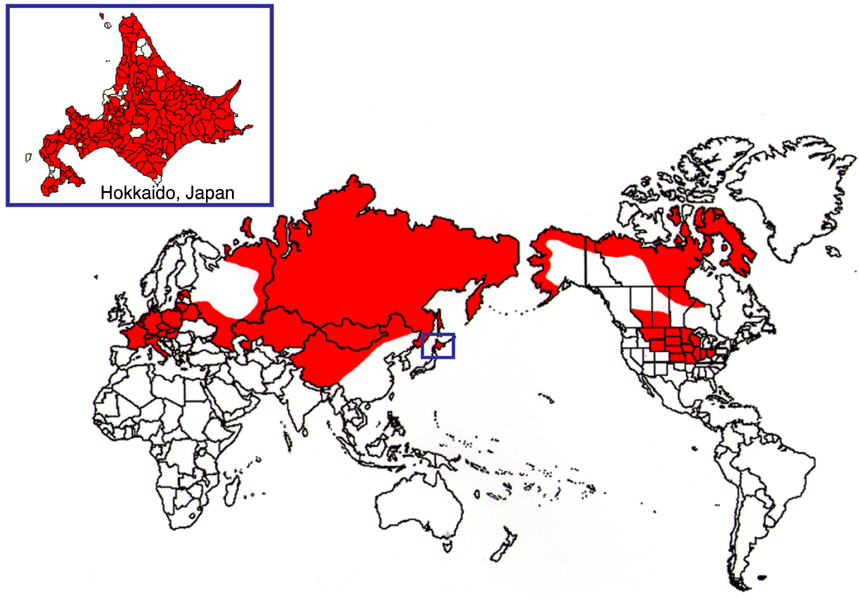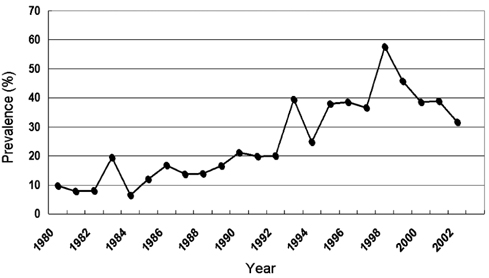J Vet Sci.
2007 Dec;8(4):313-321. 10.4142/jvs.2007.8.4.313.
Collaborative control initiatives targeting zoonotic agents of alveolar echinococcosis in the northern hemisphere
- Affiliations
-
- 1OIE Reference Laboratory for Echinococcosis and Laboratory of Environmental Zoology, Department of Biosphere and Environmental Sciences, Faculty of Environmental Systems, Rakuno Gakuen University, Hokkaido 069-8501, Japan. mkamiya@rakuno.ac.jp
- KMID: 1106209
- DOI: http://doi.org/10.4142/jvs.2007.8.4.313
Abstract
- Alveolar echinococcosis is one of the most important lethal zoonotic helminth infections in the northern hemisphere. Currently, the threat to public health is increasing, as evidenced by the rising prevalence rate of alveolar echinococcosis, as well as the invasion of urban areas by infected wild foxes. This threat is further increased due to the involvement of pet dogs, and probably cats, as emerging sources of infection. These increased threats to public health also have associated economic risks; therefore, there is a need for effective and sustainable methods of control. In this paper, initiatives to control alveolar echinococcosis by targeting its definitive hosts through anthelmintic baiting campaigns initiated by local residents who used local resources for bait production, distribution and collection of fecal samples for diagnosis are described. Further, when such distribution programs are coupled with the use of GIS-based maps, the optimum distribution of bait was obtained. These programs have also included the use of intravital diagnostic analyses of infection rates, which have been overseen by the Forum on Environment and Animals (FEA), and also allowed a nationwide monitoring of echinococcosis in difinitive hosts. In addition, a government initiative requiring mandatory reporting of echinococcosis in dogs to health authorities was recently initiated in Japan. Overall, the results of this study have shown that use of collaborative control initiatives targeting zoonotic agents of alveolar echinococcosis can be an effective method for reducing the threat of lethal echinococcosis in the northern hemisphere.
Keyword
MeSH Terms
Figure
Reference
-
1. Allan JC, Craig PS. Coproantigens in taeniasis and echinococcosis. Parasitol Int. 2006. 55:S75–S80.
Article2. Bružinskaitė R, Marcinkutė A, Strupas K, Sokolovas V, Deplazes P, Mathis A, Eddi C, Šarkūnas M. Alveolar echinoccoccosis, Lithuania. Emerg Infect Dis. 2007. 13:1618–1619.3. Craig PS. Torgerson PR, Shaikenov BS, editors. Epidemiology of echinococcosis in western China. Echinococcosis in Central Asia: Problems and Solution. 2004. Almaty: Publishing House Dauir;43–58.4. Craig PS. Echinococcus multilocularis. Curr Opin Infect Dis. 2003. 16:437–444.
Article5. Dag Hammarskjöld Foundation. The 1975 Dag Hammarskjöld Report on Development and International Cooperations. 1982. Uppsala, Sweden: Dag Hammarskjöld Foundation;28.6. Deplazes P. Ecology and epidemiology of Echinococcus multilocularis in Europe. Parassitologia. 2006. 48:37–39.7. Deplazes P, Hegglin D, Gloor S, Romig T. Wilderness in the city: the urbanization of Echinococcus multilocularis. Trends Parasitol. 2004. 20:77–84.8. Doi R, Matsuda H, Uchida A, Kanda E, Kamiya H, Konno K, Tamashiro H, Nonaka N, Oku Y, Kamiya M. Possibility of invasion of Echinococcus into Honshu with pet dogs from Hokkaido and overseas. Nippon Koshu Eisei Zasshi. 2003. 50:639–649.9. Doi R, Nakao M, Nihei N, Kutsumi H. Epidemiology of alveolar hydatid disease (AHD) and estimation of infected period of AHD on Rebun Island, Hokkaido. Nippon Koshu Eisei Zasshi. 2000. 47:145–152.10. Eckert J, Deplazes P. Biological, epidemiological, and clinical aspects of echinococcosis, a zoonosis of increasing concern. Clin Microbiol Rev. 2004. 17:107–135.
Article11. Ewald D, Eckert J, Gottstein B, Straub M, Nigg H. Parasitological and serological studies on the prevalence of Echinococcus multilocularis Leuckart, 1863 in red foxes (Vulpes vulpes Linnaeus, 1758) in Switzerland. Rev Sci Tech. 1992. 11:1057–1061.
Article12. Gottstein B, Saucy F, Deplazes P, Reichen J, Demierre G, Busato A, Zuercher C, Pugin P. Is high prevalence of Echinococcus multilocularis in wild and domestic animals associated with disease incidence in humans? Emerg Infect Dis. 2001. 7:408–412.
Article13. Hansen F, Tackmann K, Jeltsch F, Wissel C, Thulke HH. Controlling Echinococcus multilocularis-ecological implications of field trials. Prev Vet Med. 2003. 60:91–105.
Article14. Hegglin D, Ward PI, Deplazes P. Anthelmintic baiting of foxes against urban contamination with Echinococcus multilocularis. Emerg Infect Dis. 2003. 9:1266–1272.
Article15. Hofer S, Gloor S, Muller U, Mathis A, Hegglin D, Deplazes P. High prevalence of Echinococcus multilocularis in urban red foxes (Vulpes vulpes) and voles (Arvicola terrestris) in the city of Zurich, Switzerland. Parasitology. 2000. 120:135–142.
Article16. Holt DW, Hanns C, O'Hara T, Burek K, Frantz R. New distribution records of Echinococcus multilocularis in the brown lemming from Barrow, Alaska, USA. J Wildl Dis. 2005. 41:257–259.
Article17. Inceboz T, Korkmaz M, Tokat Y, Uner A. The first report of Echinococcus multilocularis strain isolation from human in Turkey. Turkiye Parazitol Derg. 2005. 29:31–33.18. Kamiya M, Lagapa JT, Ganzorig S, Kobayashi F, Nonaka N, Oku Y. Echinococcosis risk among domestic definitive hosts, Japan. Emerg Infect Dis. 2007. 13:346–347.
Article19. Kamiya M, Lagapa JT, Nonaka N, Ganzorig S, Oku Y, Kamiya H. Current control strategies targeting sources of echinococcosis in Japan. Rev Sci Tech. 2006. 25:1055–1065.20. Kamiya M, Lagapa JT, Oku Y. Research on targeting sources of alveolar echinococcosis in Japan. Comp Immunol Microbiol Infect Dis. 2007. 30:427–448.
Article21. Kamiya M, Nonaka N, Ganzorig S, Oku Y. Torgerson PR, Shaikenov BS, editors. Effective countermeasures against alveolar echinococcosis in the red fox population of Hokkaido, Japan. Echinococcosis in Central Asia: Problems and Solutions. 2004. Almaty: Publishing House Dauir;273–282.22. Kapel CM, Torgerson PR, Thompson RC, Deplazes P. Reproductive potential of Echinococcus multilocularis in experimentally infected foxes, dogs, raccoon dogs and cats. Int J Parasitol. 2006. 36:79–86.
Article23. Kern P, Bardonnet K, Renner E, Auer H, Pawlowski Z, Ammann RW, Vuitton DA, Kern P. European Echinococcosis Registry. European echinococcosis registry: human alveolar echinococcosis, Europe, 1982-2000. Emerg Infect Dis. 2003. 9:343–349.
Article24. Konno K, Oku Y, Tamashiro H. Prevention of alveolar echinococcosis-ecosystem and risk management perspectives in Japan. Acta Trop. 2003. 89:33–40.
Article25. Manfredi MT, Casulli A, La Rosa G, Di Cerbo AR, Trevisio K, Genchi C, Pozio E. Echinococcus multilocularis in north Italy. Parassitologia. 2006. 48:43–46.26. Mathis A, Deplazes P. Copro-DNA tests for diagnosis of animal taeniid cestodes. Parasitol Int. 2006. 55:S87–S90.
Article27. Moks E, Saarma U, Valdmann H. Echinococcus multilocularis in Estonia. Emerg Infect Dis. 2005. 11:1973–1974.28. Morishima Y, Sugiyama H, Arakawa K, Kawanaka M. Echinococcus multilocularis in dogs, Japan. Emerg Infect Dis. 2006. 12:1292–1294.29. Myjak P, Nahorski W, Pietkiewicz H, von Nickisch-Rosenegk M, Stolarczyk J, Kacprzak E, Felczak-Korzybska I, Szostakowska B, Lucius R. Molecular confirmation of human alveolar echinococcosis in Poland. Clin Infect Dis. 2003. 37:e121–e125.
Article30. Nonaka N, Kamiya M, Oku Y. Towards the control of Echinococcus multilocularis in the definitive host in Japan. Parasitol Int. 2006. 55:S263–S266.31. Oku Y. Expansion of the distribution of Echinococcus multilocularis which propagates and spreads in the human body. J Modern Vet Med. 2000. 48:5–17.32. Oku Y, Kamiya M. Otsuru M, Kamegai S, Hayashi S, editors. Biology of Echinococcus. Progress of Medical Parasitology in Japan. 2003. Vol. 8. Tokyo: Meguro Parasitological Museum;293–318.33. Rausch RL, Wilson JF, Schantz PM. A programme to reduce the risk of infection by Echinococcus multilocularis: the use of praziquantel to control the cestode in a village in the hyperendemic region of Alaska. Ann Trop Med Parasitol. 1990. 84:239–250.
Article34. Rist A. Endogenous development as a social learning process. Compas Magazine. 2004. 7:26–29.35. Romig T, Dinkel A, Mackenstedt U. The present situation of echinococcosis in Europe. Parasitol Int. 2006. 55:S187–S191.
Article36. Schelling U, Frank W, Will R, Romig T, Lucius R. Chemotherapy with praziquantel has the potential to reduce the prevalence of Echinococcus multilocularis in wild foxes (Vulpes vulpes). Ann Trop Med Parasitol. 1997. 91:179–186.
Article37. Schweiger A, Ammann RW, Candinas D, Clavien PA, Eckert J, Gottstein B, Halkic N, Muellhaupt B, Prinz BM, Reichen J, Tarr PE, Torgerson PR, Deplazes P. Human alveolar echinococcosis after fox population increase, Switzerland. Emerg Infect Dis. 2007. 13:878–882.
Article38. Shaikenov BS. Distribution and ecology of Echinococcus multilocularis in Central Asia. Parasitol Int. 2006. 55:S213–S219.39. Storandt ST, Virchow DR, Dryden MW, Hygnstrom SE, Kazacos KR. Distribution and prevalence of Echinococcus multilocularis in wild predators in Nebraska, Kansas, and Wyoming. J Parasitol. 2002. 88:420–422.
Article40. Tackmann K, Loschner U, Mix H, Staubach C, Thulke HH, Ziller M, Conraths FJ. A field study to control Echinococcus multilocularis-infections of the red fox (Vulpes vulpes) in an endemic focus. Epidemiol Infect. 2001. 127:577–587.
Article41. Thompson RC, Kapel CM, Hobbs RP, Deplazes P. Comparative development of Echinococcus multilocularis in its definitive hosts. Parasitology. 2006. 132:709–716.42. Tsukada H, Hamazaki K, Ganzorig S, Iwaki T, Konno K, Lagapa JT, Matsuo K, Ono A, Shimizu M, Sakai H, Morishima Y, Nonaka N, Oku Y, Kamiya M. Potential remedy against Echinococcus multilocularis in wild red foxes using baits with anthelmintic distributed around fox breeding dens in Hokkaido, Japan. Parasitology. 2002. 125:119–129.
Article43. Tsukada H, Morishima Y, Nonaka N, Oku Y, Kamiya M. Preliminary study of the role of red foxes in Echinococcus multilocularis transmission in the urban area of Sapporo, Japan. Parasitology. 2000. 120:423–428.
Article44. Vuitton DA, Zhou H, Bresson-Hadni S, Wang Q, Piarroux M, Raoul F, Giraudoux P. Epidemiology of alveolar echinococcosis with particular reference to China and Europe. Parasitology. 2003. 127:S87–S107.
Article45. Wang Q, Vuitton DA, Qiu J, Giraudoux P, Xiao Y, Schantz PM, Raoul F, Li T, Yang W, Craig PS. Fenced pasture: a possible risk factor for human alveolar echinococcosis in Tibetan pastoralist communities of Sichuan, China. Acta Trop. 2004. 90:285–293.
Article46. Yagi K, Takahashi K, Hattori K. A case of immature Echinococcus multilocularis in a domestic cat in Nemuro, eastern Hokkaido, Japan. Rep Hokkaido Inst Pub Health. 1984. 34:68–69.47. Yamamoto N, Morishima Y, Kon M, Yamaguchi M, Tanno S, Koyama M, Maeno N, Azuma H, Mizusawa H, Kimura H, Sugiyama H, Arakawa K, Kawanaka M. The first reported case of a dog infected with Echinococcus multilocularis in Saitama prefecture, Japan. Jpn J Infect Dis. 2006. 59:351–352.48. Yimam AE, Nonaka N, Oku Y, Kamiya M. Prevalence and intensity of Echinococcus multilocularis in red foxes (Vulpes vulpes schrencki) and raccoon dogs (Nyctereutes procyonoides albus) in Otaru City, Hokkaido, Japan. Jpn J Vet Res. 2002. 49:287–296.49. Zinsstag J. Animal health research. Science. 2007. 315:1193.
Article
- Full Text Links
- Actions
-
Cited
- CITED
-
- Close
- Share
- Similar articles
-
- A Case of Human Hepatic Alveolar Echinococcosis Accompanied by Lung and Brain Metastases
- Recurrent Hepatic Alveolar Echinococcosis: Report of The First Case in Korea with Unproven Infection Route
- A Case of Alveolar Echinococcosis Occurring in the Hilar Bile Duct
- A Rapid and Convenient Method for in Vivo Fluorescent Imaging of Protoscolices of Echinococcus multilocularis
- Factors Associated with Echinococcosis-Induced Perioperative Anaphylactic Shock




